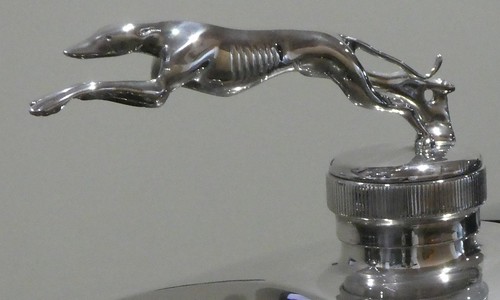The origins of the Lincoln automobile began in 1917 when Henry M. Leland and his son Wilfred Leland had a heated argument with Billy Durant of Cadillac. The Lelands left Cadillac and formed the Lincoln Motor Company which produced Liberty airplane engines for World War I. Following the war, they were faced with the problem of what to do with their large aircraft engine factory and its 6,000 employees. As a solution, they turned to making automobiles. The Lincoln V8 premiered in the Fall of 1920.
Unlike other V8 engines at this time, such as the one used in Cadillac, the Lincoln V8 used a 60⁰ angle between the cylinder banks rather than the 90⁰ angle used in other V8s. The Lincoln with a touring body had a top speed of 80 mph. Prices ranged from $4,300 to $6,600 (compared with $3,740 to $5,690 for Cadillac).
Before the first Lincoln rolled out of the plant, over 1,000 orders had been placed for the new car. In his book The American Automobile: A Centenary 1893-1993, Nick Georgano reports:
“Unfortunately a number of these were cancelled when buyers saw the cars; the engineering and performance were acceptable, but the body styling seemed uninspired, even old-fashioned.”
The Lelands had projected sales of 6,000 automobiles for the first year but only sold 3,407. In February 1922, the company was put up for sale. Ford bought the company for $8 million. Ford could have loaned the Lelands the money to keep their company afloat, but he preferred to wait until the company was in receivership and then purchase it so that he would be in control. Nick Georgano reports:
“Ford promised to spend at least two hours a day with Henry Leland sorting out any problems that might arise, but he never saw the Lelands again.”
In 1922, a total of 5,767 Lincolns were produced and annual produced increased to 8,858 by 1926 (in comparison, Cadillac produced 27,340 cars in 1926).
Shown below are some of the classic Lincolns displayed in the LeMay—America’s Automobile Museum in Tacoma, Washington.
1923 Lincoln 124A Touring Car
This car has a V8, 358 cubic inch, 90 horsepower engine.






1924 Lincoln Model L Towncar
According to the Museum:
“Considered to be one of the most elegant of chauffeur-driven automobiles of the 1920s, the Lincoln Model L Towncar was introduced in 1924. Known for quality and prestige, the Model L quickly became the choice for the rich and famous, such as Thomas Edison, W. C. Fields, and Herbert Hoover.”
The Model L Towncar on display features a body by Coachbuilder Judkins. It has a 90 horsepower, 358 cubic inch engine.






1930 Lincoln L Brougham
According to the Museum:
“The rear passenger compartment has small fold-out ‘jump seats.’ The doors are in the front-opening style that was popular on comparably high-end cars of the time. The design allowed chauffeurs easy access when opening the door for passengers.”
The body on this vehicle is by Brunn and Co.
This car has a V8, 348.8 cubic inch, 90 horsepower engine.




More automobiles
Museums 101: Lincoln and Mercury in the Classic Auto Museum (Photo Diary)
Museums 101: A Lincoln and a Cadillac from the 1950s (photo diary)
Packard Museum: The 1920s (photo diary)
WAAAM: Automobiles of the 1920s (Photo Diary)
Museums 101: Automobiles of the 1920s (Photo Diary)
America's Car Museum: Some cars of the 1920s (photo diary)
Museums 101: Packards in America's Car Museum (Photo Diary)
LeMay Family Collection: Some cars from 1920-1924 (photo diary)


